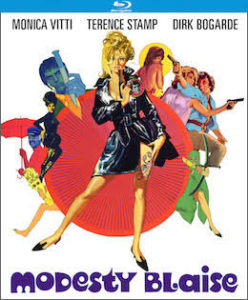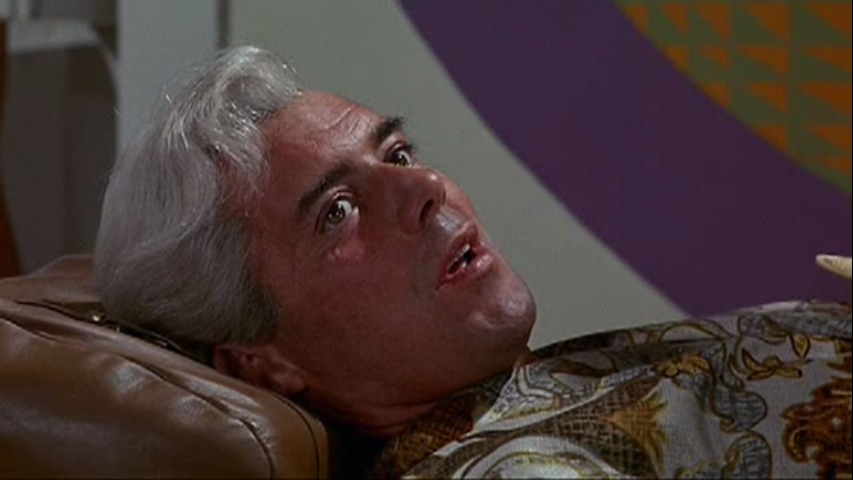’60s Spy Spoof Feels Like It’s Stuck There Forever
DIRECTED BY: JOSEPH LOSEY/1966
STREET DATE: AUGUST 23, 2016/KINO LORBER
 The Saudi Arabian sheik’s diamonds have been stolen, and Britain’s top man on the case has just been blown to bits, so who can the good guys turn to? Hey, why not use a thief to catch a thief? Why not call Modesty Blaise? The story, as it were, rolls out of this premise. The result: a time capsule of mid-’60s England as it wanted to be seen: high fashions, forward sexuality, glittering fun, and op-art on every available surface. But for all the promise of the premise, the allure of the poster, and the popularity of the source material (the British comic strip of the same name, launched a few years prior, was a huge hit), what we have is a kind of kaleidoscope in slow motion, a lot of murky plot to go with the bright array. Whatever energy the film has comes out of the clothing, set design, and late-to-the-game French New Wave techniques (jump cuts, zooms), while so little comes out of the plot or the characters, who seem somewhat leaden for a purported Bond spoof, that the two-hour running time feels more like three. One gets the feeling of not just needing to have been around in 1966 to get it, but that it needs to be 1966 right now to catch the vibe.
The Saudi Arabian sheik’s diamonds have been stolen, and Britain’s top man on the case has just been blown to bits, so who can the good guys turn to? Hey, why not use a thief to catch a thief? Why not call Modesty Blaise? The story, as it were, rolls out of this premise. The result: a time capsule of mid-’60s England as it wanted to be seen: high fashions, forward sexuality, glittering fun, and op-art on every available surface. But for all the promise of the premise, the allure of the poster, and the popularity of the source material (the British comic strip of the same name, launched a few years prior, was a huge hit), what we have is a kind of kaleidoscope in slow motion, a lot of murky plot to go with the bright array. Whatever energy the film has comes out of the clothing, set design, and late-to-the-game French New Wave techniques (jump cuts, zooms), while so little comes out of the plot or the characters, who seem somewhat leaden for a purported Bond spoof, that the two-hour running time feels more like three. One gets the feeling of not just needing to have been around in 1966 to get it, but that it needs to be 1966 right now to catch the vibe.
 It’s clear director Joseph Losey wasn’t into the source material. He had been a victim of the HUAC Hollywood purges of the early ’50s and won his accolades as an ex-patriot in London, turning out darkly satirical attacks on power and class (The Servant, one of three team-ups with writer Harold Pinter, being the most pointed). By 1966, he could choose his own projects, and must have seen the script for Modesty Blaise, which has the government as the true bad guys double-crossing our fair hero, as another launching pad for decrying duplicity in high places. But the material doesn’t line up with Losey’s bent toward the cerebral and detached, and – according to the commentary track – long-time Losey go-to actor and friend Dirk Bogarde told him outright that the movie wasn’t funny, and took to writing most of his own dialogue. Bogarde’s performance as evil super-criminal Gabriel is, in fact, the most entertaining element in the movie, taking what could have been a bad cliché and informing it with a broadly knowing and debauched worldliness that, while not exactly funny, is at least memorable. Monica Vitti, poster girl for Antonionian ennui, plays Modesty and seems game for the fun, but she’s cast as a glamorous thief with a nasty streak, yet with nothing too terribly fun, glamorous, or nasty to actually do. She floats, as does Terence Stamp as her partner in crime, Willie Garvin (also from the comic strip), who spends much of his screen time simply not wearing a shirt. Theirs is a platonic relationship with a hint of will-they-or-won’t-they, but any exploration is sidestepped for yet another long and mushy action set piece.
It’s clear director Joseph Losey wasn’t into the source material. He had been a victim of the HUAC Hollywood purges of the early ’50s and won his accolades as an ex-patriot in London, turning out darkly satirical attacks on power and class (The Servant, one of three team-ups with writer Harold Pinter, being the most pointed). By 1966, he could choose his own projects, and must have seen the script for Modesty Blaise, which has the government as the true bad guys double-crossing our fair hero, as another launching pad for decrying duplicity in high places. But the material doesn’t line up with Losey’s bent toward the cerebral and detached, and – according to the commentary track – long-time Losey go-to actor and friend Dirk Bogarde told him outright that the movie wasn’t funny, and took to writing most of his own dialogue. Bogarde’s performance as evil super-criminal Gabriel is, in fact, the most entertaining element in the movie, taking what could have been a bad cliché and informing it with a broadly knowing and debauched worldliness that, while not exactly funny, is at least memorable. Monica Vitti, poster girl for Antonionian ennui, plays Modesty and seems game for the fun, but she’s cast as a glamorous thief with a nasty streak, yet with nothing too terribly fun, glamorous, or nasty to actually do. She floats, as does Terence Stamp as her partner in crime, Willie Garvin (also from the comic strip), who spends much of his screen time simply not wearing a shirt. Theirs is a platonic relationship with a hint of will-they-or-won’t-they, but any exploration is sidestepped for yet another long and mushy action set piece.
 The source material didn’t do well in the U.S., due mostly to erratic publication forced by its occasional nudity, adding a literal function to the term comic strip. Ultimately, the British audience was disappointed because the comic was changed for the movie, while the American audience was confused because they didn’t know the characters to begin with and all they got was a meandering plot and a lot of labored camp. As for today’s audience, it’s been so primed by the Austin Powers movies and their glib, crass, smart-dumb spoofiness of this sort of thing, that to look back at what they’re spoofing is to beg disappointment. After all, Austin Powers isn’t spoofing Bond, really, but all the movies and shows that capitalized on the Bond world, either for straight-up, co-opted action or for laughs, baby, yeah. Many did it well: The Avengers, Our Man Flint, the Harry Palmer movies – The Ipcress File is my favorite Bondian serio-spoof. Modesty Blaise, on the other hand, had me looking for the next jetpack outta there.
The source material didn’t do well in the U.S., due mostly to erratic publication forced by its occasional nudity, adding a literal function to the term comic strip. Ultimately, the British audience was disappointed because the comic was changed for the movie, while the American audience was confused because they didn’t know the characters to begin with and all they got was a meandering plot and a lot of labored camp. As for today’s audience, it’s been so primed by the Austin Powers movies and their glib, crass, smart-dumb spoofiness of this sort of thing, that to look back at what they’re spoofing is to beg disappointment. After all, Austin Powers isn’t spoofing Bond, really, but all the movies and shows that capitalized on the Bond world, either for straight-up, co-opted action or for laughs, baby, yeah. Many did it well: The Avengers, Our Man Flint, the Harry Palmer movies – The Ipcress File is my favorite Bondian serio-spoof. Modesty Blaise, on the other hand, had me looking for the next jetpack outta there.
The images in this review are not representative of the actual Blu-ray’s image quality, and are included only to represent the film itself.

